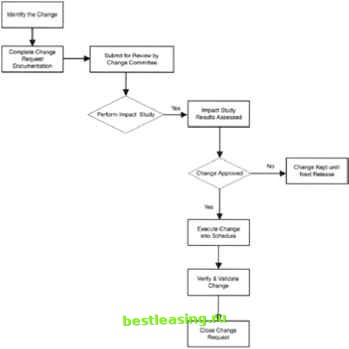

 |
 |

|
Промышленный лизинг
Методички
iJJ..HI8 Change Control Process When we speak about change control, then I have to address the whole issue of scope creep, both on the end users side and on the developers. The business plan (should) define the value that will result from the expenditure of money and resources. This value definition needs to be translated into specific measurable requirements that then become the functional specifications for the developers. Then the change management process can track the impact of new insights and understandings as the project matures without losing scope of what it was that was originally determined to have enough business value to warrant the project in the first place. A change management process should control changes in any project environment affecting products or services being developed by the project team. A core change team must assess the impact of any proposed changes to gauge cost, schedule, documentation, and training, plus the changes impact on retooling implications. The change management process identifies, defines, evaluates, and approves these changes before any implementation. This configuration management process must be introduced to the project, through the implementation of five key formal processes for: Submission and receipt of change requests. Review and logging of change requests. Determination of the feasibility of change requests. Approval of change requests. Implementation and closure of change requests. Figure 8.5 provides an overview of the change processes and procedures for effectively managing project-related change.  Figure 8.5: Change control process. Submit Change Request This process provides the ability for any member of the project team to submit a request for change to the project. The following procedures are completed: Change requestor identifies a requirement for change to any aspect of the project (e.g., scope, deliverables, time scales, organization). Change requestor completes a change request form (CRF) and distributes the form to the change manager. The CRF provides a summary of the change required, including the: Change description. Reasons for change (including business drivers). Benefits of change. Costs of change. Impacts of change. Supporting documentation. Review Change Request This process allows the change manager to review the CRF and determine whether a full feasibility study is required for the change approval group to assess the full impact of the change. The decision is based primarily on the: Number of change options presented. Complexity of the change options requested. Scale of the change solutions proposed. The change manager opens a change request in the change log and records whether a change feasibility study is required. Identify Change Feasibility This process involves the completion of a full change feasibility study to ensure that all change options have been investigated and presented accordingly. The change feasibility study involves definition of the: Requirements. Options. Costs and benefits. Risks and issues. 1 2 3 4 5 6 7 8 9 10 11 12 13 14 15 16 17 18 19 20 21 22 23 24 25 26 27 28 29 30 31 32 33 34 35 36 37 38 39 40 41 42 43 44 45 46 47 48 49 50 51 52 53 54 55 56 57 58 59 60 61 62 63 64 65 66 67 68 69 70 71 72 73 74 75 76 77 [ 78 ] 79 80 81 82 83 84 85 86 87 88 89 90 91 92 93 94 95 96 97 98 99 100 101 |